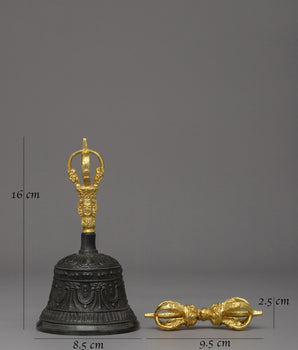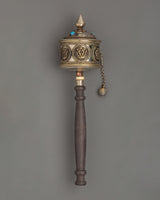
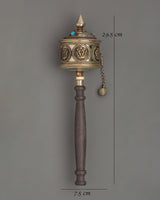
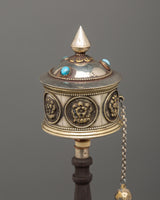
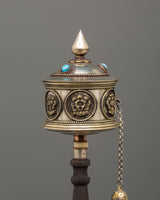
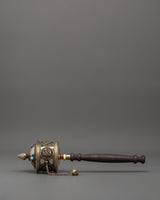
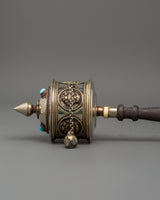
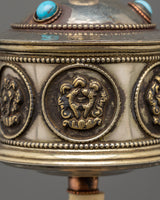
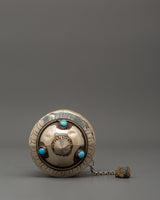
Tibetan Prayer Wheel with Auspicious Symbols | Sacred Religious Tool
Tibetan Prayer Wheel with Auspicious Symbols | Sacred Religious Tool
--------------------------------------------------------
Size: 29.5cm(Height) x 7.5cm(Width)
Weight: 0.16kg
Materials: Brass, Copper, Wood, Artificial Stones: Turquoise, Coral
--------------------------------------------------------
About our Prayer Wheel
This Tibetan Prayer Wheel, with its elaborate carvings of auspicious symbols, is a precious instrument for meditation and everyday practice. It is 29.5cm tall and 7.5cm broad, making it ideal for hand spinning during meditation or rituals. The wheel's body is made of brass and copper, and it is embellished with turquoise and coral stones, which are thought to offer healing and balance.
The wood handle provides a sturdy and comfortable grip, allowing for smooth spinning as you focus on prayers or mantras. Traditionally filled with scrolls of mantras such as Om Mani Padme Hum, spinning the prayer wheel is believed to have the same impact as repeating the prayers aloud. This item is ideal for use during meditation, spiritual rituals, or as a meaningful addition to your altar or personal holy area. Its bigger size and remarkable craftsmanship make it both a practical ritual item and an appealing spiritual remembrance.
Introduction to Prayer Wheel
A prayer wheel is cylindrical on a spindle and is used in Tibetan Buddhism. It is typically inscribed with the mantra "Om Mani Padme Hum" and rotated by hand as a form of spiritual practice and to accumulate merit. Spinning the wheel is believed to have the same spiritual benefits as verbally reciting the mantra. The use of prayer wheels is widespread in Tibetan Buddhism and has spread to other cultures.
How does the Buddhist Prayer Wheel benefit us?
The benefits associated with rotating the wheel are numerous. It promotes knowledge, compassion, and bodhicitta in the practitioner and improves siddhis (spiritual powers such as clairvoyance, precognition, etc.). The practitioner can repeat the mantra as often as possible while the wheel is rolling, maintaining a calm, meditative attitude. A Tibetan Buddhist tradition holds that after a practice session, one should dedicate any acquired merits to the benefit of all sentient beings. Then three times Om Ah Hum. This is usually among Tibetans after finishing any Buddhist practice, including the prayer wheel exercise.
How do you set up your own Buddhist Shrine?
• Find a clean, quiet, and uncluttered spot
• Set up an altar table and cover it with an altar cloth that calls to you
• Place your sacred item at the center









